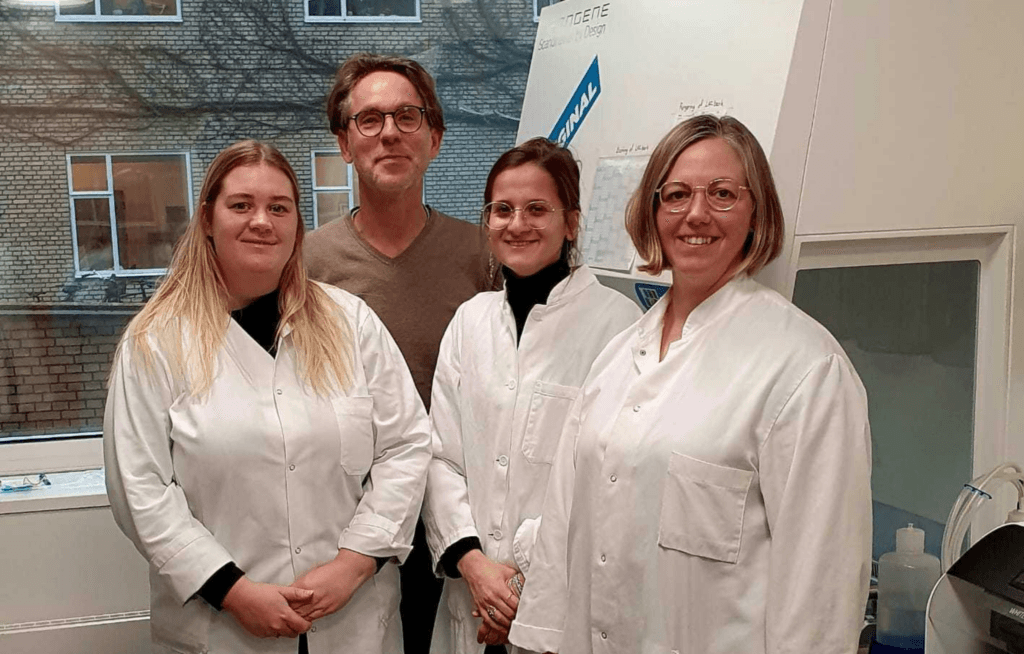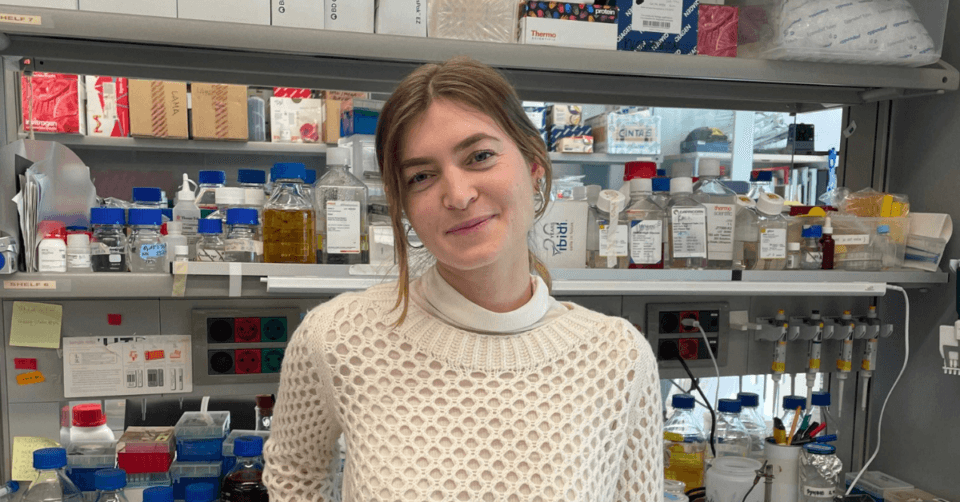07 February 2025
Collaboration is at the heart of Nastassia Knödlseder’s approach to research. A new grant from the LEO Foundation’s Visiting Researchers program allows the German-born biologist to bridge her knowledge with the expertise at Aarhus University. The next challenge for her and her colleagues: Upgrading a bacterium, so it helps skin stay healthy.
It is not always easy to recognize a research breakthrough, just after it happens. Some scientific discoveries are slow burners, as they pave the way for others and grow in importance over time.
In Nastassia Knödlseder’s case the recognition had an unusual clarity. It arrived last year with an article in Nature Biotechnology: She had succeeded in editing a skin bacterium named Cutibacterium acnes to reduce sebum, a trigger for acne. And while the result could be summarized in one headline – this is how it is – it did not convey all the hours in the lab before publication.
Knödlseder was less than sure about going for a research career in the beginning. The 32-year-old biologist started out by doing a double degree in chemistry and biochemistry in Munich – “the workload was a lot,” she says – but found her balance, as she moved across European university institutions. At Uppsala University she loved the style of teaching with small classes and experienced a calm sense of focus. At Barcelona’s University Pompeu Fabra she found her research team. This spring she brings in new collaborators, when she visits Aarhus University as a part of the LEO Foundation’s Visiting Researchers program. The grant from the Foundation allows her to work closely with Associate Professor at the Department of Biomedicine, Holger Brüggemann.
“When I began my Ph.D. on C. acnes, I came across Holger Brüggemann’s articles that are foundational on the topic. Our calls have been regular since, so he is already a voice that inspires my research. But when you are physically together in the same lab, your collaboration becomes easier,” she says.
She highlights Brüggemann as a mentor together with Marc Güell who was her Ph.D. advisor and leads her research group back in Barcelona.
“He contributed to my fascination related to synthetic biology: The idea that you can engineer living cells to do what you want.”
Running against time in the lab
For the project supported by the LEO Foundation, Güell remains a source of advice, while her own knowledge encounters Brüggemann’s expertise. Knödlseder brings in the ability to give C. acnes a new function, which was the core of the article in Nature Biotechnology. Brüggemann adds his understanding of hyaluronic acid that exists naturally in the skin and ensures its elasticity. Over time an enzyme degrades hyaluronic acid. Here lies the call for a potential solution.
“My previous research on C. acnes shows that we can give a bacterial strain another purpose within the skin’s own structure. This time we aim to replace an enzyme in the strain that degrades hyaluronic acid with one that strengthens it,” Knödlseder says.
They do not know if it will work yet. Ahead lies the continuous trial and error in the lab.
“I want to fit a certain number of experiments into each day, and you can get the feeling that you never have enough time. There are days when the project is not moving forward, and it gets you down. But you cannot be too affected by it. Staying positive and curious is the recipe for a happy scientific mind. I have discovered that I have the ability to go on and try again.”

Cecilie Feidenhansl, Holger Brüggemann, Erinda Rruci and Lise Hald Schultz.
Problem-solving for the many
Working with C. acnes sets a few specific conditions. The baguette-shaped microbe does not thrive if it is exposed to oxygen. It prefers the environment of the human skin, deep inside the acidic hair follicles. This means that every edit in the lab needs to happen fast.It is followed by one week of waiting, because the bacteria grow slowly in response to the edit.
“I am amazed that you can make living cells address problems. If you want that opportunity, you have to adapt to some rules.”
The prospect of a bacterial strain that retains hyaluronic acid in the skin is interesting as it reduces inflammation and maintains skin hydration. These are components of several skin diseases, including acne and psoriasis.
“I am motivated by the fact that our research at some point could help the many. A serious skin disorder has a significant impact on your mental well-being.”
Before she became aware of the scenarios of problem-solving, it was her mother that sparked her interest in skin.
“I remember her always pushing for using sunscreen, and so I grew up trying to understand how I could care for my skin. Later I realized how each condition is never about one thing. It always comes down to multiple factors. One of them is figuring out what kind of bacteria might be beneficial to us.”
About Nastassia Knödlseder

- Postdoctoral researcher at University Pompeu Fabra in Barcelona.
- Field of research: How precise genetic engineering can use bacteria to produce new molecules – in this case hyaluronic acid ones – for the skin’s benefit.
- Will collaborate with Aarhus University from March as a part of the LEO Foundation Visiting Researchers program.
“The program makes it possible for us to develop something between two universities. It speeds up processes to work together onsite and be a part of a skin-focused research institution such as Aarhus University,” Nastassia Knödlseder says.
